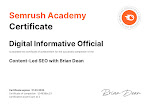The Comprehensive Guide to Search Engine Marketing: Strategies for Success
The Comprehensive Guide to Search Engine Marketing: Strategies for Success
Introduction to Search Engine Marketing
In the dynamic world of digital marketing, Search Engine Marketing (SEM) stands out as a critical tool for businesses aiming to thrive online. SEM, a blend of SEO and paid advertising strategies, offers a unique opportunity to increase visibility, drive traffic, and enhance brand recognition in the digital space.
Understanding SEM: The Fusion of SEO and Paid Advertising
At its core, SEM combines the best of SEO (Search Engine Optimization) and paid advertising. SEO focuses on optimizing your website to rank higher in organic search results, while paid advertising involves paying for ads to appear alongside search results. Together, these strategies create a powerful synergy, boosting your online presence and reaching your target audience more effectively.
Keyword Research: The Foundation of SEM
The first step in any SEM strategy is keyword research. Identifying the right keywords – the terms and phrases your target audience uses when searching online – is crucial. These keywords guide your content creation and ad targeting, ensuring that your efforts resonate with your audience’s interests and needs.
Creating Compelling Content: The Heart of SEO
The backbone of SEO is high-quality, relevant content. This includes blog posts, articles, info graphics, and videos that provide value to your audience. By creating content that answers their questions, solves their problems, and engages them, you not only improve your SEO but also establish your brand as an authority in your field.
On-Page Optimization: Fine-Tuning Your Website
On-page optimization involves refining individual web pages to rank higher in search engines. This includes optimizing title tags, meta descriptions, header tags, and images. Ensuring that your website is mobile-friendly, fast-loading, and easy to navigate also plays a significant role in on-page optimization.
Link Building: Strengthening Your Online Authority
Link building, the process of acquiring links from other websites to your own, is a vital component of SEO. High-quality, relevant backlinks from authoritative sites signal to search engines that your content is valuable, boosting your site’s credibility and rankings.
Paid Advertising: Maximizing Visibility and Reach
Paid advertising, such as Google Ads and Bing Ads, complements your SEO efforts by placing your brand directly in front of your target audience. With options like pay-per-click (PPC) advertising, you can control your budget while targeting specific demographics, locations, and even times of day.
Measuring SEM Success: Analytics and Adjustment
Continuous monitoring and adjustment are key to SEM success. Using tools like Google Analytics, you can track your website’s performance, understand your audience’s behavior, and refine your strategies accordingly. This data-driven approach ensures that your SEM efforts are always aligned with your business goals.
Staying Ahead: Adapting to SEM Trends and Changes
The digital marketing landscape is constantly evolving, and so are SEM strategies. Staying informed about the latest trends, algorithm updates, and best practices is essential for maintaining and improving your online presence.
Conclusion
Effective SEM is a combination of well-researched keywords, compelling content, on-page optimization, strategic link building, and targeted paid advertising. By mastering these elements, you can significantly enhance your online visibility, attract more traffic, and achieve your business objectives.






















Post a Comment